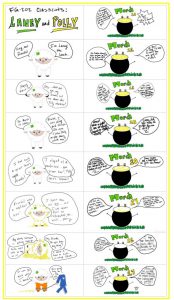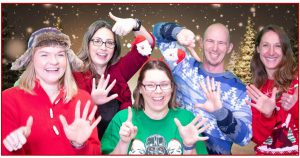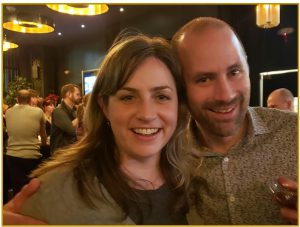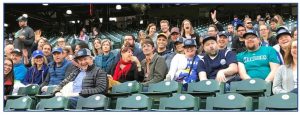(1) develops mutually respectful and productive relationships with colleagues
(2) partners consistently with colleagues on projects (i.e. integration, service learning)
(3) engages in collegial activities hosted by the school
Without a doubt, my favorite part about the EPS community is my colleagues. I find them engaged, engaging, passionate, creative, innovate, dedicated, intelligent, funny, and supportive, to name a few common attributes. The community of educators that we have built over the years continually feeds me with ideas, resources to implement them, and feedback about how to improve them. Strong working relationships are, and always have been, a critical component of employment at EPS; the give and take is a core part of our culture.
(1) develops mutually respectful and productive relationships with colleagues
One of the more fortunate changes I have made in my time at EPS was to move my desk into a classroom shared with my 5th-grade colleague, Anthony Colello. He welcomed (even if he didn’t invite) me into the space, let me set up my materials across the whiteboard from him, and take over sections of his previously sacred wall and mind space.

The benefits that come from sharing the room far outweigh any challenges (of which there weren’t many), and have led to a respectful and productive professional relationship and a strong personal friendship. The professional pieces are visible in a lot of ways, one of which is the integration between Intro to Historical Thinking (Anthony’s 5th-grade class) and Intro to Literary Thinking (my 5th-grade class). An instance of integration is The Explorer Project, which spans both classes over several weeks; research, note-taking, and historical content happen in Intro to Historical Thinking, while synthesizing, drafting, and presenting happen in Intro to Lit. We share rubrics, provide coordinated checklists for peer reviewing, and talk daily about the progress of our students. Another professional connection seems whimsical and “extra,” but goes so, so far in creating a connected culture in the 5th-grade space; I speak, of course, about our FG-202 classcots (see right). These whiteboard drawings (again, started by Anthony and co-opted by me) engage in trivial and/or poignant conversations with each other and the students. Each month’s characters have their own personalities, a schtick, and a unique way of engaging within the classroom environment. Classcots are legendary among middle schoolers, making their way into assignments and conversations, and remembered long into upper school years by “lifers” (I’m sure …). Perhaps most importantly, they give Anthony and me joy as we curate the month-long stories.
I write about the New Parent Series (NPS) in other sections of this portfolio; it was born from this proximity in work space. As Anthony and I informally exchanged stories about parent conversations while working in the classroom, we realized that there were commonalities between our experiences. As the 5th- and 6th-grade Grade Level Coordinators, Anthony and I (respectively) came to the realization that parents didn’t understand the philosophies behind our programs. New families worried that their children wouldn’t be asked back if they failed a single test, for example; they questioned how much help to give their children at home; if they didn’t see regular communication from us, they assumed we weren’t giving any at all. There was a genuine disconnect that we discovered, and our ability to informally talk through the issues in our shared office led to the creation of the NPS.
(2) partners consistently with colleagues on projects (i.e. integration, service learning)
 One constant partnership that I maintain throughout the course of the school year is with my grade-level advisory team. The main goal of our team is to support the 6th graders as they move through their year, so we try to focus our work and attention in that direction, making sure that the needs of the students are mirrored in the culture of our team. The five of us partner on many levels on many projects, from weekly class meetings and advisories to service learning and EBC adventures. As the coordinator of the group, I try to engage other team members as much as possible in programming, planning, and implementing; year after year, I see that we produce more effective activities when we lean on and leverage each other’s strengths. When Ryan Winkelmann was on the team, for example, we relied on him as our game guy; he could craft crazy games understood and enjoyed only by 11-year-olds, keeping them entertained, active, thinking, and working together for entire class periods. In another example, Molly Lori and Krissy Russell lead our once-a-trimester gratitude and meditation class meeting, where they garnered their focused energy, creative ideas, and calm, thoughtful ways to help the students practice mindfulness in the middle of a busy day. Each member of the team – no matter who is on the team (and it DOES change every year!) – has something different to offer, and when those abilities are put to good use, the team and program become stronger.
One constant partnership that I maintain throughout the course of the school year is with my grade-level advisory team. The main goal of our team is to support the 6th graders as they move through their year, so we try to focus our work and attention in that direction, making sure that the needs of the students are mirrored in the culture of our team. The five of us partner on many levels on many projects, from weekly class meetings and advisories to service learning and EBC adventures. As the coordinator of the group, I try to engage other team members as much as possible in programming, planning, and implementing; year after year, I see that we produce more effective activities when we lean on and leverage each other’s strengths. When Ryan Winkelmann was on the team, for example, we relied on him as our game guy; he could craft crazy games understood and enjoyed only by 11-year-olds, keeping them entertained, active, thinking, and working together for entire class periods. In another example, Molly Lori and Krissy Russell lead our once-a-trimester gratitude and meditation class meeting, where they garnered their focused energy, creative ideas, and calm, thoughtful ways to help the students practice mindfulness in the middle of a busy day. Each member of the team – no matter who is on the team (and it DOES change every year!) – has something different to offer, and when those abilities are put to good use, the team and program become stronger.
(3) engages in collegial activities hosted by the school
 I feel quite lucky to like so many of my colleagues. Truly, there’s something to appreciate and value about each one of them, and often I find out about those qualities outside of the school day. Attending collegial activities hosted by the school gives me insight into the personal lives that don’t often get to exist in the classroom. One of our annual traditions, the holiday party, comes at a tough time of the year; we’re all tired in December, aching for the rest and respite that Winter Break brings. Every year, I consider not going because I’m just worn out, and, every year, I attend anyway because there’s something comforting about being worn out together. We talk about trips, families, presents, and plans over drinks and food. We relax and reconnect, leading us to remember why we like each other in the first place.
I feel quite lucky to like so many of my colleagues. Truly, there’s something to appreciate and value about each one of them, and often I find out about those qualities outside of the school day. Attending collegial activities hosted by the school gives me insight into the personal lives that don’t often get to exist in the classroom. One of our annual traditions, the holiday party, comes at a tough time of the year; we’re all tired in December, aching for the rest and respite that Winter Break brings. Every year, I consider not going because I’m just worn out, and, every year, I attend anyway because there’s something comforting about being worn out together. We talk about trips, families, presents, and plans over drinks and food. We relax and reconnect, leading us to remember why we like each other in the first place.
The school works as well as it does because of the relationships we create and maintain. Over the years, I have gained so much from the generous people around me, and I hope that as I grow into more mentor roles I am able to continue to be an integral part of passing along the collegial dynamics and culture that we have worked so hard to maintain for the first 17 years of the school.